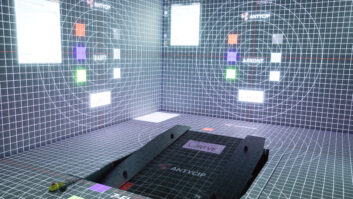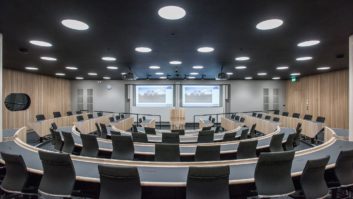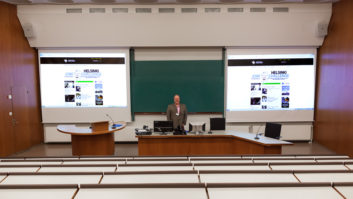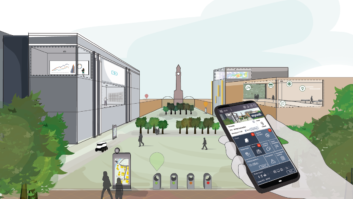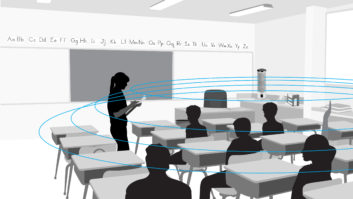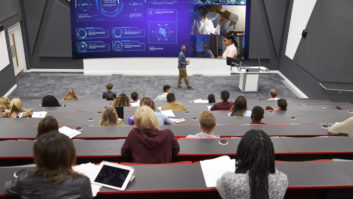
The UK’s education system is at a crossroads. As schools tentatively reopen and lockdown restrictions begin to ease, educators are trying to navigate the ever-changing regulatory landscape and work out how to make the future of learning fit for purpose. Cambridge University has already taken the lead in confirming all its lectures for the next academic term will be delivered online, with many other schools and universities following suit. Now more than ever, AV technology is helping teachers and students stay connected and mitigating the impacts of the pandemic.
The lockdown has forced educational institutions to accelerate the adoption of digital teaching methods for remote learning, using AV technology to live-stream video lessons, assess classwork and share resources with students. But this is a pivotal moment for education: will schools revert to traditional classroom set-ups or will they continue to implement new technologies to support distance learning?
The digital demand
Teachers around the world have been able to quickly realise the benefits of EdTech – using software platforms to increase student engagement and collaboration, beyond the traditional classroom environment. In fact, more than 89 per cent of educators believe technology is now integral to everyday life, so it should be present in education. Research has also shown distance learning can improve student comprehension and the retention of key information, making a strong case for the technologies implemented during lockdown to play a much bigger role in a post-coronavirus world.
Given the current need for innovation in education, teachers and schools need to find sustainable and scalable solutions to comply with social distancing guidelines. This will inevitably mean bolstering the digital toolkit available for teachers to enable them to effectively deliver the curriculum via distance learning. Using technology in the classroom is not new, interactive whiteboards and tablets are used in many classrooms, but the current situation demands we take this a step further.
As physical classrooms go digital, technology is blurring the lines between remote and in-person learning. With cloud-based software platforms such as myViewBoard, teachers can do more than just present content. They can live-stream lessons via video conferencing, embed videos, annotate lesson materials, create quizzes, and give feedback in real time. Any annotated lesson materials can be automatically uploaded to the cloud and accessed remotely by pupils or their parents, at a time that suits them. This allows students the flexibility to engage with their education on their own terms and get a better understanding of their own learning style.
Educators must consider all the key stages when structuring teaching programmes and ensure they are able to adapt teaching methods for different ages and needs. AV technology is an incredibly versatile tool which can be used to bridge this gap. For example, students deemed ‘at-risk’ or with ill health can use these digital tools and resources to collaborate with teaching staff and peers remotely, in real time, and ensure their education does not suffer simply because they cannot attend class in-person.
- Schoolroom Solutions campaign launched to help education facilities
- Our industry is the glue holding society together
- AV Technology Awards: the winners
Diversifying learning
As educational leaders consider their next steps, it is important to find a balance between traditional and digital teaching strategies and embrace the power of education technology to support this transformation. AV technology does not necessarily have to replace physical teaching, rather it can be used to complement and enhance traditional methods through what is known as hybrid learning.
Hybrid or ‘blended’ learning is an educational strategy which combines online digital teaching with traditional classroom methods. While EdTech has already proved successful in creating effective hybrid teaching environments for higher education, the challenge now is to scale up this technology to primary and secondary schools as a way of supporting students’ education which would otherwise suffer massively.
For many schools, the move to hybrid learning will be born out of necessity. With limited physical space and classes limited to 15 pupils as a means of adhering to social distancing policy, technology is the only way to ensure students remain engaged and connected to their education.
Hybrid teaching does not come without its challenges. The transition will not be instantaneous and adapting teaching pedagogies takes time. In fact, a survey carried out by UNESCO found 60 per cent of teachers in 60 countries said they were not sufficiently prepared to carry out remote learning online. The coronavirus outbreak has forced teachers to act but as the initial threat of the virus begins to ease, and we now look ahead at the long-term future of education in the UK, it is clear AV technology must play a greater role.
It is essential for decision makers to implement easy-to-install, intuitive and agnostic software and hardware solutions to support teaching staff in the transition from traditional to hybrid teaching methods.
A pivotal moment
To say the coronavirus outbreak, and consequent lockdown, has been a highly challenging test for the education sector would be an understatement. Schools and colleges across the country are now relying on AV technology and the wider AV industry to ensure children of all ages can continue to learn and develop. Now is the time for us to work together with educators to rethink how we teach future generations and enable them to benefit from the power of technology.
James Jepson is solutions sales director – UK & Ireland at ViewSonic.
